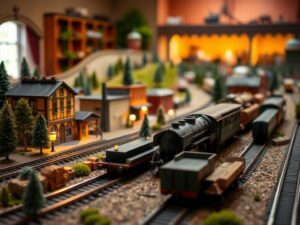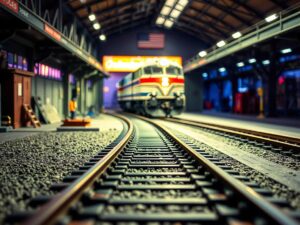Best DCC Systems for HO Scale Beginners
Best DCC Systems for HO Scale Beginners
Best DCC Systems for HO Scale Beginners
Welcome aboard! You’ve dipped your toes into the magical world of model railroading, and now you’re eyeing DCC â Digital Command Control. Itâs like giving your trains super powers, allowing you to control speed, direction, sound effects, even lights with incredible precision. This blog post is dedicated to helping YOU navigate the fantastic world of DCC, especially if you’re working on an HO scale layout.
Let’s unravel this tech and find the best DCC systems for HO Scale beginners.
Why DCC? Why HO?
Before diving into specific brands and systems, let’s address the âwhyâ.
DCC (Digital Command Control) revolutionizes your railroad experience by ditching those clunky mechanical throttles. Imagine:
* Individual Train Control: Each locomotive becomes a separate entity, allowing for smooth acceleration and deceleration, realistic switching scenarios, and multiple trains running at different speeds on a single track.
* Soundscape Creation: DCC lets you activate sound effects – whistles, bells, engine roars â to create an immersive soundscape that brings your railroad alive.
* Advanced Functionality: You can program specific actions for individual trains â automatic stopping, reversing at set points, even triggering lighting sequences.
Now, HO scale â the darling of model railroading! This means models are roughly proportional to the real world, offering detailed miniature trains and scenery. Perfect for showcasing realistic operations on your layout.
* DCC Starter Systems: The Essential Toolkit*
Starting with DCC can feel overwhelming. Luckily, manufacturers offer excellent “starter sets” that bundle the essential components at an approachable price point:
- Control Panel (Throttle): This handheld device sends digital signals to control individual trains. It usually features a knob for speed control and buttons for directional reversal and sound activation.
- DCC Booster: This is the powerhouse of your DCC system, delivering enough electricity to run your entire layout and trains at various speeds. Boosters can range in power output (amps) depending on your layout size.
- Layout Bus Wire/Cable: These connect everything together, running from the control panel, to the booster, to all parts of your track.
Top DCC Brands for Beginners
Choosing a brand is a personal decision, but here’s a rundown of some popular options, comparing their strengths and considerations:
-
Hornby Digital: A great entry-level choice with user-friendly interfaces, reliable performance, and reasonable pricing. They often include pre-programmed locomotive sounds in their starter sets.
- Best for: Beginners looking for affordability and ease of use.
-
Esu LokSound: Renowned for incredible sound quality and realistic train operation. While their basic systems might be slightly more expensive than Hornby, the added detail and realism make it a great choice if sound is crucial to you.
- Best for: Model railroaders prioritizing advanced features and audio fidelity.
-
Digitrax:
This brand offers robust systems with an impressive range of features, from DCC accessory decoders to sophisticated control software. Their technology is favored by experienced hobbyists who crave advanced functionality and customization options.
- Best for: Enthusiasts seeking high-end performance and expansion capabilities.
-
Athearn/Atlas/Lionel (Brand-Specific Systems):
These popular brands sometimes offer DCC systems tailored to their own locomotives and tracks, providing seamless integration for dedicated hobbyists using a single manufacturer’s products. These are usually good starter options if youâre already invested in one particular brand of model trains.
- Best for: Hobbyists committed to a specific brand and seeking brand-specific compatibility.
Choosing Your Best DCC System
Now that weâve explored some key options, how do you pick the right system? Ask yourself these questions:
1. Whatâs your budget? DCC starter sets can range from around $100 to well over $300. Set a realistic spending limit. 2. How complex do you want your layout to be? Simple setups may only need a basic DCC starter system, while more intricate layouts might benefit from additional boosters or accessory decoders for lights and sound effects.
-
Sound is Crucial? If life-like engine sounds are a must, ESU LokSound sets often set the benchmark.
-
Future Expansion: Will you be adding new features or larger track layouts down the line? Consider systems with upgrade possibilities and expandability options.
-
Manufacturer Loyalty? If you’re already invested in one brand, their own DCC system might be a convenient and compatible choice.
Resources for Continued Learning:
- DCC Resources Online:
The Model Railroader Forums (forums.trains.com) offer a wealth of knowledge from seasoned DCC users and expert advice tailored to specific brands.
* YouTube Channels: Countless tutorials and demonstrations break down complex DCC concepts in an engaging visual format.
Don’t be afraid to reach out, ask questions, and learn! The model railroading community is incredibly welcoming and eager to help you on your journey. Welcome aboard, and may your digital adventures be filled with endless possibilities!




